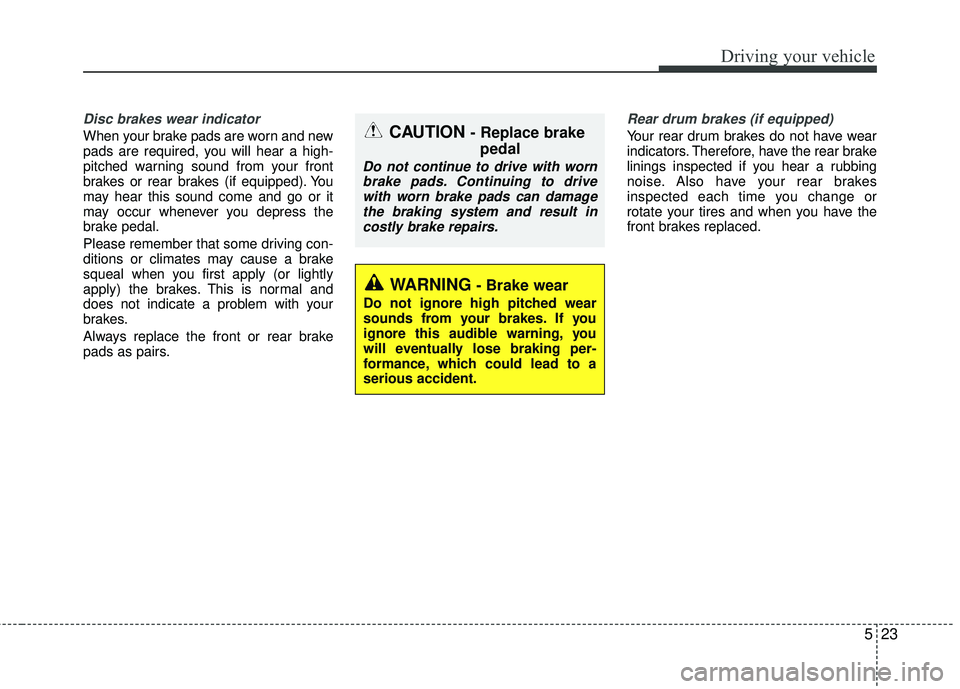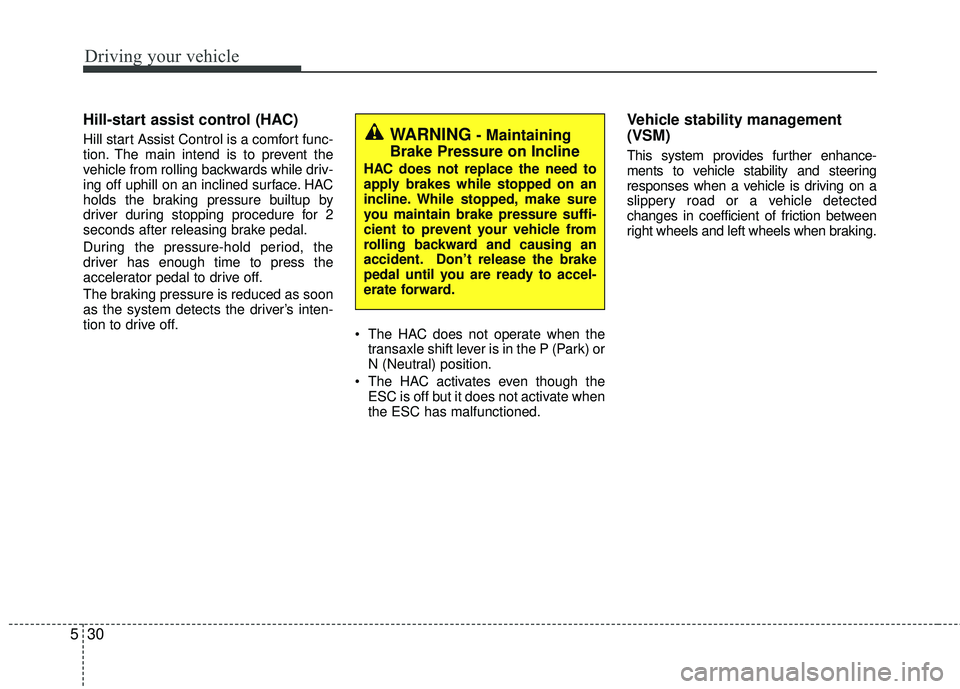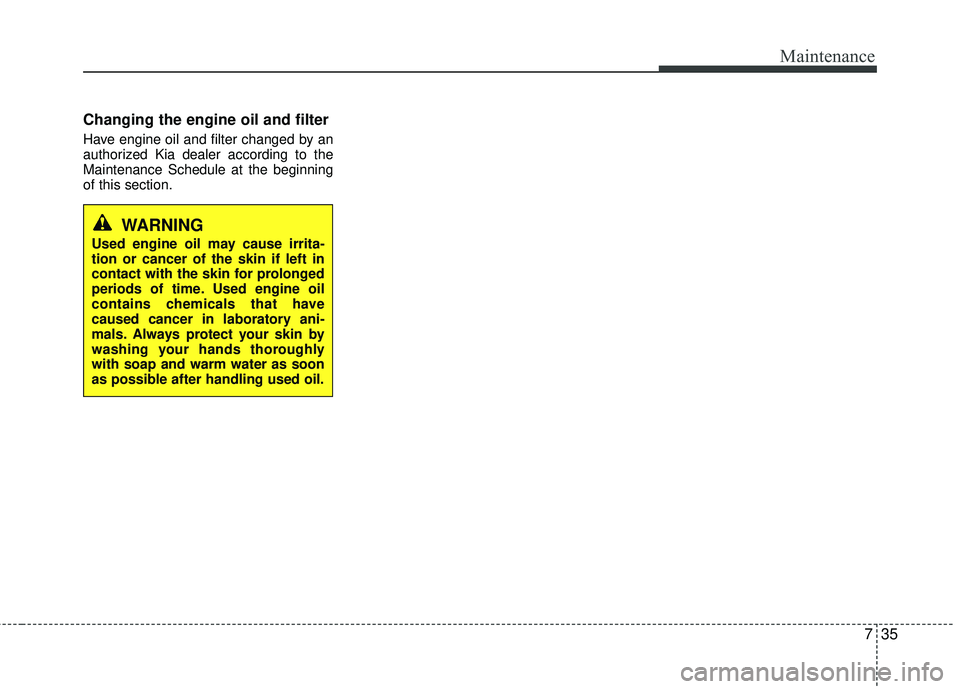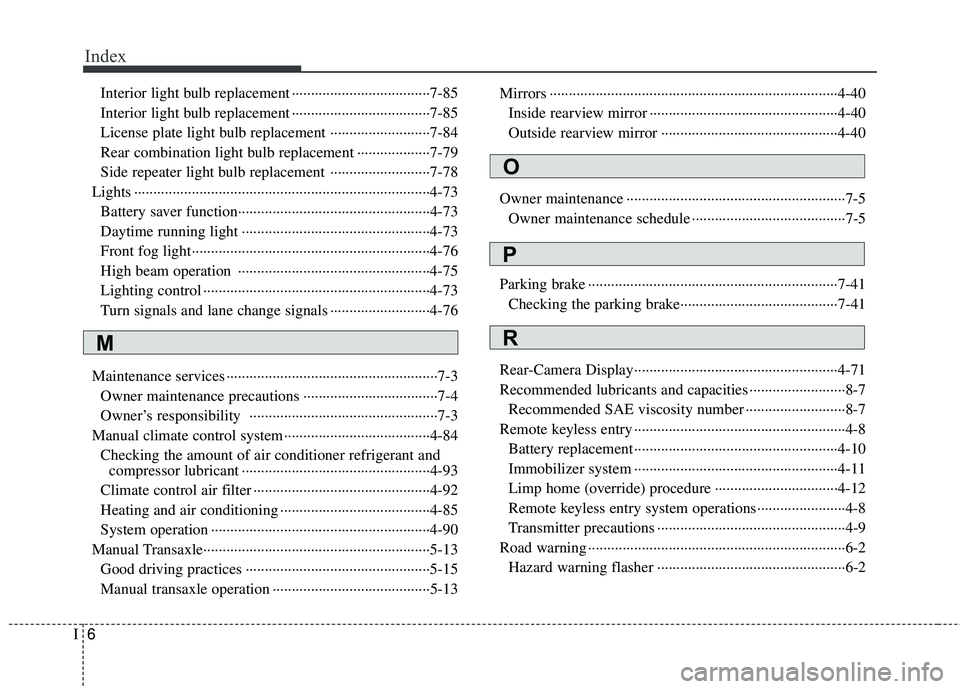2017 KIA RIO change time
[x] Cancel search: change timePage 255 of 449

Driving your vehicle
85
ACC(Accessory)
Press the ENGINE START/STOP button
while it is in the OFF position without
depressing the brake pedal.
The electrical accessories are opera-
tional.
If the ENGINE START/STOP button is in
the ACC position for more than 1 hour,
the button is turned off automatically to
prevent battery discharge.
ON
Press the ENGINE START/STOP button
while it is in the ACC position without
depressing the brake pedal.
The warning lights can be checked
before the engine is started. Do not leave
the ENGINE START/STOP button in the
ON position for a long time. The battery
may discharge, because the engine is
not running.
START/RUN
To start the engine, depress the brake
pedal and press the ENGINE START/
STOP button with the shift lever in the P
(Park) or the N (Neutral) position. For
your safety, start the engine with the shift
lever in the P (Park) position.
If you press the ENGINE START/STOP
button without depressing the brake
pedal, the engine will not start and the
button will change as follow:
OFF ➔ ACC ➔ON ➔OFF
OrangeBlueNot illuminated
Page 270 of 449

523
Driving your vehicle
Disc brakes wear indicator
When your brake pads are worn and new
pads are required, you will hear a high-
pitched warning sound from your front
brakes or rear brakes (if equipped). You
may hear this sound come and go or it
may occur whenever you depress the
brake pedal.
Please remember that some driving con-
ditions or climates may cause a brake
squeal when you first apply (or lightly
apply) the brakes. This is normal and
does not indicate a problem with your
brakes.
Always replace the front or rear brake
pads as pairs.
Rear drum brakes (if equipped)
Your rear drum brakes do not have wear
indicators. Therefore, have the rear brake
linings inspected if you hear a rubbing
noise. Also have your rear brakes
inspected each time you change or
rotate your tires and when you have the
front brakes replaced.
WARNING- Brake wear
Do not ignore high pitched wear
sounds from your brakes. If you
ignore this audible warning, you
will eventually lose braking per-
formance, which could lead to a
serious accident.
CAUTION - Replace brakepedal
Do not continue to drive with worn
brake pads. Continuing to drivewith worn brake pads can damagethe braking system and result incostly brake repairs.
Page 277 of 449

Driving your vehicle
30
5
Hill-start assist control (HAC)
Hill start Assist Control is a comfort func-
tion. The main intend is to prevent the
vehicle from rolling backwards while driv-
ing off uphill on an inclined surface. HAC
holds the braking pressure builtup by
driver during stopping procedure for 2
seconds after releasing brake pedal.
During the pressure-hold period, the
driver has enough time to press the
accelerator pedal to drive off.
The braking pressure is reduced as soon
as the system detects the driver’s inten-
tion to drive off.
The HAC does not operate when the
transaxle shift lever is in the P (Park) or
N (Neutral) position.
The HAC activates even though the ESC is off but it does not activate when
the ESC has malfunctioned.
Vehicle stability management
(VSM)
This system provides further enhance-
ments to vehicle stability and steering
responses when a vehicle is driving on a
slippery road or a vehicle detected
changes in coefficient of friction between
right wheels and left wheels when braking.
WARNING- Maintaining
Brake Pressure on Incline
HAC does not replace the need to
apply brakes while stopped on an
incline. While stopped, make sure
you maintain brake pressure suffi-
cient to prevent your vehicle from
rolling backward and causing an
accident. Don’t release the brake
pedal until you are ready to accel-
erate forward.
Page 283 of 449

Driving your vehicle
36
5
To decrease the cruising speed:
Follow either of these procedures:
Move the lever (1) down (to SET-) and
hold it. Your vehicle will gradually slow
down. Release the lever at the speed
you want to maintain. Move the lever (1) down (to SET-) and
release it immediately. The cruising
speed will decrease by 1.6 km/h (1.0
mph) each time the lever is operated in
this manner.
To temporarily accelerate with the
cruise control on:
If you want to speed up temporarily when
the cruise control is on, depress the
accelerator pedal. Increased speed will
not interfere with the cruise control oper-
ation or change the set speed.
To return to the set speed, take your foot
off the accelerator.
OUB055082K
OUB055083K
■ Type A
■Type B
Page 367 of 449

731
Maintenance
EXPLANATION OF SCHEDULED MAINTENANCE ITEMS
Engine oil and filter
The engine oil and filter should be
changed at the intervals specified in the
maintenance schedule. If the vehicle is
being driven in severe conditions, more
frequent oil and filter changes are
required.
Drive belts
Inspect all drive belts for evidence of
cuts, cracks, excessive wear or oil satu-
ration and replace if necessary. Drive
belts should be checked periodically for
proper tension and adjusted as neces-
sary.
Fuel filter (cartridge)
A clogged filter can limit the speed at
which the vehicle may be driven, damage
the emission system and cause multiple
issues such as hard starting. If an exces-
sive amount of foreign matter accumu-
lates in the fuel tank, the filter may
require replacement more frequently.
After installing a new filter, run the engine
for several minutes, and check for leaks
at the connections. Fuel filters should be
installed by an authorized Kia dealer.
Fuel filter (for gasoline)
Kia gasoline vehicle is equipped a life-
time fuel filter that integrated with the fuel
tank. Regular maintenance or replace-
ment is not needed but depends on fuel
quality. If there are some important safe-
ty matters like fuel flow restriction, surg-
ing, loss of power, hard starting problem
etc, fuel filter inspection or replace is
needed.
The fuel filter be Inspected or replaced
by an authorized Kia dealer.
Fuel lines, fuel hoses and con-
nections
Check the fuel lines, fuel hoses and con-
nections for leakage and damage. Have
an authorized Kia dealer replace any
damaged or leaking parts immediately.
Vapor hose and fuel filler cap
The vapor hose and fuel filler cap should
be inspected at those intervals specified
in the maintenance schedule. Make sure
that a new vapor hose or fuel filler cap is
correctly replaced.
Vacuum crankcase ventilation
hoses (if equipped)
Inspect the surface of hoses for evidence
of heat and/or mechanical damage. Hard
and brittle rubber, cracking, tears, cuts,
abrasions, and excessive swelling indi-
cate deterioration. Particular attention
should be paid to examine those hose
surfaces nearest to high heat sources,
such as the exhaust manifold.
Inspect the hose routing to assure that
the hoses do not come in contact with
any heat source, sharp edges or moving
component which might cause heat dam-
age or mechanical wear. Inspect all hose
connections, such as clamps and cou-
plings, to make sure they are secure, and
that no leaks are present. Hoses should
be replaced immediately if there is any
evidence of deterioration or damage.
Page 371 of 449

735
Maintenance
Changing the engine oil and filter
Have engine oil and filter changed by an
authorized Kia dealer according to the
Maintenance Schedule at the beginning
of this section.
WARNING
Used engine oil may cause irrita-
tion or cancer of the skin if left in
contact with the skin for prolonged
periods of time. Used engine oil
contains chemicals that have
caused cancer in laboratory ani-
mals. Always protect your skin by
washing your hands thoroughly
with soap and warm water as soon
as possible after handling used oil.
Page 446 of 449

Index
6I
Interior light bulb replacement ··················\
··················\
7-85
Interior light bulb replacement ··················\
··················\
7-85
License plate light bulb replacement ··················\
········7-84
Rear combination light bulb replacement ··················\
·7-79
Side repeater light bulb replacement ··················\
········7-78
Lights ··················\
··················\
··················\
··················\
·····4-73 Battery saver function··················\
··················\
··············4-73
Daytime running light ··················\
··················\
·············4-73
Front fog light··················\
··················\
··················\
········4-76
High beam operation ··················\
··················\
··············4-75
Lighting control ··················\
··················\
··················\
·····4-73
Turn signals and lane change signals ··················\
········4-76
Maintenance services ··················\
··················\
··················\
·7-3 Owner maintenance precautions ··················\
·················7-4
Owner’s responsibility ··················\
··················\
·············7-3
Manual climate control system··················\
··················\
··4-84 Checking the amount of air conditioner refrigerant andcompressor lubricant ··················\
··················\
·············4-93
Climate control air filter ··················\
··················\
··········4-92
Heating and air conditioning ··················\
··················\
···4-85
System operation ··················\
··················\
··················\
···4-90
Manual Transaxle··················\
··················\
··················\
·····5-13 Good driving practices ··················\
··················\
············5-15
Manual transaxle operation ··················\
··················\
·····5-13 Mirrors ··················\
··················\
··················\
··················\
···4-40
Inside rearview mirror ··················\
··················\
·············4-40
Outside rearview mirror ··················\
··················\
··········4-40
Owner maintenance ··················\
··················\
··················\
···7-5 Owner maintenance schedule ··················\
··················\
····7-5
Parking brake ··················\
··················\
··················\
···········7-41 Checking the parking brake··················\
··················\
·····7-41
Rear-Camera Display··················\
··················\
·················4-71\
Recommended lubricants and capacities ··················\
·······8-7 Recommended SAE viscosity number ··················\
········8-7
Remote keyless entry ··················\
··················\
··················\
·4-8 Battery replacement ··················\
··················\
·················4-10\
Immobilizer system ··················\
··················\
·················4-11\
Limp home (override) procedure ··················\
··············4-12
Remote keyless entry system operations··················\
·····4-8
Transmitter precautions ··················\
··················\
·············4-9
Road warning ··················\
··················\
··················\
·············6-2 Hazard warning flasher ··················\
··················\
·············6-2
M
O
P
R